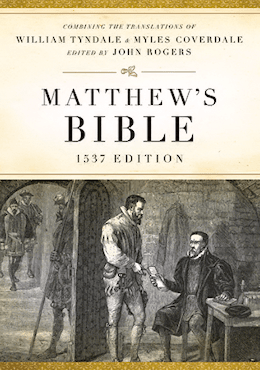Textus Receptus Bibles
Matthew's Bible 1537
| 13:1 | And I sawe a beaste ryse out of the sea, hauyng .vij. heades, and .x. hornes, and vpon his hornes ten crounes, and vpon his heade the name of blasphemye. |
| 13:2 | And the beaste whych I sawe, was lyke a cat of the mountayne, and hys fete were as the fete of a beare, and his mouth as the mouth of a Lyon. And the dragon gaue him hys power and hys seale, and great authorytye, |
| 13:3 | & I sawe one of his heades as it were wounded to death and his deadlye wounde was healed. And al the worlde wondred at the beaste, |
| 13:4 | & they worshipped the dragon, which gaue power vnto the beaste, and they worshipped the beast saiynge: who is lyke vnto the beast? who is able to warre with him? |
| 13:5 | And there was mouth geuen vnto hym, that spake greate thinges and blasphemies, and power was geuen vnto hym, to do .xlij. monethes. |
| 13:6 | And he opened hys mouth vnto blasphemy agaynste God, to blaspheme hys name, and his tabernacle and them that dwell in heauen. |
| 13:7 | And it was geuen vnto hym to make warre wyth the Saynctes, and to ouercome them. And power was geuen hym ouer al kynredes, tonges and nacions, |
| 13:8 | and al that dwel vpon the earth worshipte him, whose names are not written in the boke of lyfe of the lambe, which was killed from the beginning of the worlde. |
| 13:9 | Yf any man haue an eare, let hym heare. |
| 13:10 | He that leadeth into captiuitie shal go into captiuitie, he that kylleth wt a sweard, must be kylled wyth a sweard. Here is the pacience and the fayth of the sainctes. |
| 13:11 | And I behelde another beast commyng vp out of the earth, and he had two hornes lyke a lambe, and he spake as dyd the dragon. |
| 13:12 | And he, dyd al that the fyrste beast could do in his presence, and he caused the earth, and them which dwel therin, to worship the fyrst beast, whose deadly wounde was healed. |
| 13:13 | And he dyd greate wonders, so that he made fyre come doune from heauen in the syght of men. |
| 13:14 | And deceiued them that dwelt on the earth by the meanes of those sygnes, which he had power to do in the syght of the beaste, saying to them that dwelt on the earth, that they should make an ymage vnto the beaste, whyche had the wounde of a swearde, and dyd lyue. |
| 13:15 | And he had power to geue a spyryte vnto the ymage of the beaste, and that the ymage of the beast should speake, and shoulde cause that as manye as would not worshyppe the ymage of the beaste, shoulde be kylled. |
| 13:16 | And he made al both smale and greate, ryche and poore, free and bonde, to receyue a marke in theyr ryght handes, or in theyr forheades. |
| 13:17 | And that no man myghte by or sell, saue he that had the marke, or the name of the beaste, other the numbre of his name. |
| 13:18 | Here is wysdom. Let him that hath wyt counte the numbre of the beaste. For it is the numbre of a man, and hys numbre is syxe hundred thre score and syxe. |

Matthew's Bible 1537
The Matthew Bible, also known as Matthew's Version, was first published in 1537 by John Rogers, under the pseudonym "Thomas Matthew". It combined the New Testament of William Tyndale, and as much of the Old Testament as he had been able to translate before being captured and put to death, with the translations of Myles Coverdale as to the balance of the Old Testament and the Apocrypha, except the Apocryphal Prayer of Manasses. It is thus a vital link in the main sequence of English Bible translations.